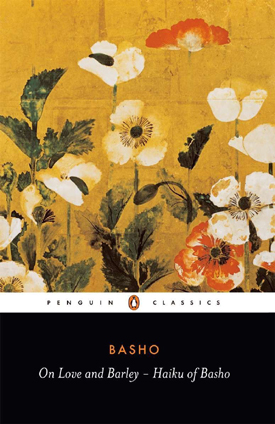 Basho is, to many, synonymous with haiku. He took his name from a wide-leaf banana tree, rare in Japan, given to him by a student, which stood beside the door of his hut near Edo (modern Tokyo). Basho wrote during a time of renascence in Japan, the beginning of the Tokugawa Shogunate in the 17th Century, when the power of the Emperors moved from Kyoto to Edo, although the Emperors stayed in Kyoto, and purely indigenous forms in the arts regained their popularity. As in other art forms, haiku was strangling under the artificiality of what Lucien Stryker, the translator, calls “rulesmiths.” On Love and Barley is a collection of about one-quarter of Basho’s more than one thousand haiku.
Basho is, to many, synonymous with haiku. He took his name from a wide-leaf banana tree, rare in Japan, given to him by a student, which stood beside the door of his hut near Edo (modern Tokyo). Basho wrote during a time of renascence in Japan, the beginning of the Tokugawa Shogunate in the 17th Century, when the power of the Emperors moved from Kyoto to Edo, although the Emperors stayed in Kyoto, and purely indigenous forms in the arts regained their popularity. As in other art forms, haiku was strangling under the artificiality of what Lucien Stryker, the translator, calls “rulesmiths.” On Love and Barley is a collection of about one-quarter of Basho’s more than one thousand haiku.
Haiku as a form, or at least the idea of a form, has become familiar to Westerners in recent years as an offshoot of the New Age movement. I’m not sure why, but you can find haiku “kits” at major book chains (although I can’t imaging what use they could possibly be). Much is made of the strict form of seventeen syllables, arranged is a sequence of 5-7-5. Since Basho didn’t feel himself strongly bound by this arrangement, even though a traditionalist, Stryker quite wisely renders the poems in forms ranging anywhere from seven to fifteen syllables (as a point of interest, most writers working in haiku in English favor eleven to fifteen syllables – English and Japanese just don’t seem to convey the same amount of information in a syllable). Much more important to Basho, however, was the real structure of the poem: the condition and the sudden perception, divided by a “break” – usually accomplished by punctuation in English.
(111)
Rain-washed
camellia – as it
falls, showers.
Basho’s haiku, as well as his other poetry, were deeply influenced by Zen Buddhism. An inveterate traveler, he eventually became a monk and it is this spirit that permeates his poems. He stressed karumi, “lightness,” which Stryker describes as “the artistic expression of non-attachment, the result of calm realization of profoundly felt truths.” Added to this are sabi, a sort of “contented solitariness,” and wabi, an appreciation of the commonplace.
(120)
Atop the mushroom –
who knows from where –
a leaf?
(121)
Birth of art –
song of rice planters,
chorus from nowhere.
The influence of Zen on Basho’s poetry is problematical in one regard only: whether Zen was ultimately in the service of art, or art in the service of Zen, which to me seems a very Zen dilemma. That Basho was one of Japan’s greatest poets seems indisputable: his influence is still being felt, and his popularity remains constant. These small-scale works seem admirably suited for contemplation; that they are, at the very least, also charming is a bonus.
Lucien Stryker, a well-known poet himself, has published a book of essays titled Encounter with Zen: Writings on Poetry and Zen, and has translated other Japanese poets, as well as Japanese and Chinese Zen poetry. His translations seem to have found the core of Basho’s poems, bringing us over 250 small, thoughtful jewels.
(Penguin Classics, 1986)
